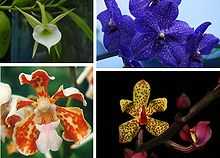Vandeae
| Vandeae | |
|---|---|
 | |
| Various examples of Vandeae | |
| Scientific classification | |
| Kingdom: | Plantae |
| (unranked): | Angiosperms |
| (unranked): | Monocots |
| Order: | Asparagales |
| Family: | Orchidaceae |
| Subfamily: | Epidendroideae |
| Tribe: | Vandeae |
| Subtribes | |
| |
The Vandeae is a large monophyletic tribe within the family of orchids.
This tribe contains 1,700 - 2,000 species in more than 150 genera. The classification of taxa within this tribe is still largely based on floral morphology. Only a few attempts have been made to obtain a classification based on molecular evidence, usually based on sequence data from several plastid-encoded DNA regions.[1]
These orchids are pantropical epiphytes and occur in tropical Asia, the Pacific Islands, Australia and Africa. Many of these orchids are horticulturally important, especially Vanda and Phalaenopsis.
This tribe is subdivided into four subtribes :
- Subtribe Aeridinae (formerly, illegitimate subtribal name Sarcanthinae): largest subtribe with more than 1,000 species in 103 genera, including about 200 hybrid species; occurs mostly in Asia and Australia and with a few in Africa. They are distinguished from the other subtribes by having an entire rostellum, a relatively small spur formed by the lip, and four (or two) pollinia.
- Subtribe Aerangidinae: about 300 species in 36 genera. They are distributed through tropical Africa and Madagascar. They are distinguished from the other subtribes by having an elongate rostellum, an elongate spur, and two pollinia.
- Subtribe Angraecinae: about 400 species in 19 genera. They occur in tropical Africa, Madagascar, the Mascarene and Comoros Islands and two genera in tropical America. They are distinguished from the other subtribes by having an apron-like rostellum, an elongate spur, and two pollinia.
- Subtribe Polystachyinae (formerly part of the Epidendreae) : about 220 species in four genera : Hederorkis, Imerinaea, Neobenthamia, and Polystachya They all show four pollinia. The lip often has mealy hairs called pseudopollen on the upper surface.
See also
References
- ↑ Chase M. W. Freudenstein J. V. Cameron K. M. Barrett R. L. (2003). "DNA data and Orchidaceae systematics: a new phylogenetic classification.". Orchid conservation: 69–89.
- Cameron et al., A Phylogenetic Analysis of the Orchidaceae: Evidence from rbcL Nucleotide Sequences, American Journal of Botany 86(2): 208-224 (1999)
- Barbara S. Carlsward, W. Mark Whitten, Norris H. Williams2and Benny Bytebier (2006). "Molecular phylogenetics of Vandeae (Orchidaceae) and the evolution of leaflessness". American Journal of Botany 93 (5): 770–786. doi:10.3732/ajb.93.5.770.
![]() Media related to Vandeae at Wikimedia Commons
Media related to Vandeae at Wikimedia Commons
| Wikimedia Commons has media related to Vandeae. |